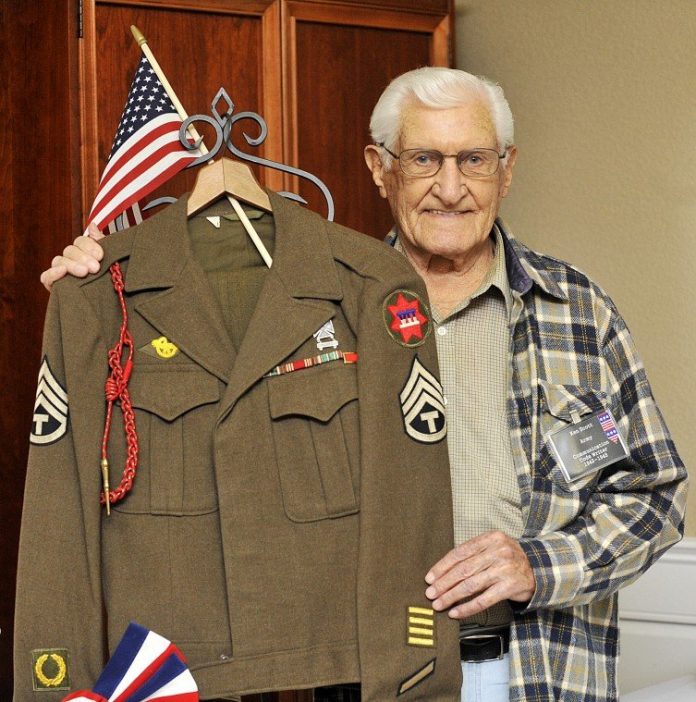
For the past six years, Gilroy history teacher Darren Yafai has established a unique tradition of assigning a project titled “Stories of Service” to students enrolled in Honors World History.
Students filter out into the community, interviewing and documenting accounts of veterans and survivors of wartime adversities such as Holocaust and Japanese internment camps. The result is an ongoing chronicle of moving memories, tales of valor, stories of sacrifice and lessons learned – each as varied as the person who tells them – be it the wife of a veteran, a soldier who fought in the Gulf War or a pilot who flew B-52 planes loaded with hydrogen bombs during the Cuban Missile Crisis.
“They are dying at a rate of one every 90 seconds,” said Yafai, who impressed a sense of “urgency” when it comes to honoring the service of WWII veterans by recording their accounts. “These are really cool stories that have a lot of ties to our curriculum and also benefit our community.”
This year, 15 teams of Honors World History students from Christopher High School recently visited veterans living in the Village Green Apartments for seniors in Gilroy. Stories were compiled by students and submitted to the Dispatch.
Galen Burquist, 86, Counter Intelligence Corporation during WWII
Galen Burquist was born on the Fourth of July in 1926. He lived on a farm in Burdick, Kan., where his father owned the local gas station. Galen had two brothers named Dean and Don. Galen attended grammar school in Burdick before he and his family moved to San Luis Obispo.
Galen lived a simple life until he was drafted after high school into the military, where he was chosen to be in the Counter Intelligence Core (C.I.C.). After the war was over, he attended school at Cal Poly State University and started a family.
Galen began working in the infantry, but was later asked to join the C.I.C. which essentially was responsible for investigating allegations of disloyalty or misconduct within the military. Most of Galen’s work was “classified.” He traveled from Germany to France, and served during the end of World War II. Galen stated that during his service he never felt lonely.
After he left his military family he returned to California and studied engineering at Cal Poly. Soon after he got married and started a family with his wife and had three children, one of who lives in Gilroy and visits him often.
Serving in the military taught Galen responsibility, and that “things happen whether you want them to or not.” You are put into situations that might take you away from everything that you’ve ever known, he says, but in the end the experience helps you learn and grow.
Galen learned how to react to things in a moment of crisis. It made him the man he is today; not taking anything for granted and cherishing life.
– Alexis Maciel, Aliyah Purnell and Lauren Bright
Art Schlessinger, 73, transportation for the U.S. Army during the Korean War
Our group interviewed an Army veteran from the Korean War named Art Schlessinger who had very interesting stories and experiences while serving this country. Art served for 20 years from 1959-1979.
Art was born in Lithuania, Germany in 1937. He was a toddler at the time when World War II started in 1939, and it ended when he was 9 years old. He was kicked out of school because his family didn’t support the Soviet Union and the communist movement. After World War II ended, Art’s family had no food to eat and he had to work in the fields. In 1953, his family moved from East Germany to West Germany, where communism wasn’t a problem.
At the age of 21, Art was drafted into the U.S. Army. In 1958, he had no other choice but to come to the U.S. alone by boat. He spoke no English because German was his native tongue, which made ordering food difficult. He went through basic training in Georgia, and was later stationed in Washington D.C. He went to Germany with the American Army, and was later stationed in Korea twice from 1963-1965 and again from 1969-1970. He served in the transportation unit, driving vehicles such as trucks, motorcycles, vans, buses and tanks filled with ammunition, artillery and troops. His last job was in Frankfurt, protecting school children from violence. Art retired in 1979 because of a heart attack. He later drove school buses in Monterey.
Even though he was forced to join the Army, Art doesn’t regret it. His most important lesson to future generations is “education.”
“Do not quit!” he said. “Finish high school and go to college if you want to be successful and have a good job.”
– Abraham Longoria, Joseph Celaya-Zepeda, Mitchell Slater and Jarrett Soares
John Price, 94, infantry machine gunner in the 37th Division for the U.S. Army
John Price was born in Delaware, Ohio in 1917. He met his wife in a restaurant when she was working there as a waitress. His friends dared him to go up and talk to her and then ask her out on a date. She replied with a “yes.” They got along pretty well and eventually got married in 1936. She was very pretty with her auburn hair.
John joined the Army at the age of 23 in 1940. During the war, he did many great things such as invading concentration camps, becoming a sergeant and knocking out 50 German tanks by blowing up their tracks. His best moment during the war was when he was in Paris, where there was good entertainment and many pretty girls.
John was in Europe when Pearl Harbor was bombed by Japan. He was in Europe for almost two years. John said that the French and German people were very nice and they did not want the war.
Many things happened when John was in Germany, where he and his fellow soldiers were even put in prison camps. John had witnessed many men blown to bits and later said that that is what should happen to Hitler. John paid attention to the German troops and noticed that they were very disorganized but they knew how to use their weapons wisely.
John was shipped home to America after the Germans surrendered and Hitler committed suicide. John met his 1-year-old daughter for the first time. John and his family moved to California, where John worked for the Jewel Tea Company for 30 years. John now has 33 grandchildren.
War is a farce and it is not worth it to have another, John says. His words of wisdom to everyone in this generation are to “be a diplomat.”
– Melissa Dillman, Alex Osborne and Ryan Cabral
Ray Roach, 90, radio man with U.S. Navy
An important role throughout WWII was that of a radio operator. Their job was to communicate with generals or soldiers. Ray Roach was a radio operator during the war and now has many stories to share.
Ray and his family were like any typical family growing up during the depression. He was born on Jan. 11, 1922 and had two brothers and sisters that he loved. Ray’s youngest brother joined the Navy and Air Force. Ray’s family lived in Nebraska, where “it was very cold and not the best environment to live in,” Ray described. San Diego was a popular place for the Roach family, as they had relatives there and visited frequently before eventually moving to the area. Ray graduated from high school in San Diego in 1940. His mom didn’t want him going into the Navy but he eventually talked her into letting him go. Ray wanted to join the Navy because he had an uncle who had formerly been in the Navy out in China.
Ray started in the Navy 18 months before WW II started. He was a radio operator and learned many skills such as Morse Code. He was first stationed in Australia before moving to Pearl Harbor. In Australia, Ray talked about how it looked like New York with all the people and different lights. In Pearl Harbor he arrived on a Friday evening, then left the next week on Friday afternoon – causing Ray to barely miss the Pearl Harbor bombing by a couple of days.
One of Ray’s most memorable yet tragic moments in the war was his ship being torpedoed. Even though bad things like this did happen, good things also happened. While Ray was in Australia he met the love of his life, Reita. Those two love birds were together for 57 years and about to reach 58 until her unexpected passing.
After the war, Ray worked for two different telephone companies. Ray said if he could go back in time, odds are he would go through the war again.
– Chloe Rivoallon, Emily O’Brien, Jasmine Pena and Kayla Gonzalez
Ken Scott, 92, code writer for the 50th Signal Battalion with the U.S. Army
Ken Scott grew up on a farm in South Dakota with his parents, three sisters and two brothers. Before he was registered in the draft, he was working for a hardware company. Ken served for three years.
In September of 1942, Ken left for Iceland to train to be a typist and radio operator. He trained for eight hours a day, seven days a week. Ken was later assigned to the 50th Signal Battalion. His best friend was also assigned to the same squad and they served together. Ken’s job was to pass codes to other typists by using the Morse Code, which is a system of lights and patterns that can only be interpreted by a machine. Ken had no idea what the code was, he only knew that his job was to copy the pattern and make sure there wasn’t a mistake. He traveled in June 1944 from Iceland to the middle of Europe in May 1945. Ken got to visit the great hall at Berchtesgaden, Germany, where Hitler had his conference room. Ken fought in five battles. He was in combat every time but was never wounded.
Ken’s future wife worked at a bank with Ken’s brother. When Ken returned, his brother set up a blind date. Ken and his wife have been together ever since and have been married for 65 years. Ken rarely mentions the war because he just wanted to get away from that and enjoy his time with his wife. They have three grandchildren and like to watch sports, eat, walk and join club activities at Village Greens.
Ken’s advice for people going for the army is that it’s different from back then, and nowadays you need to work hard and try your best to be safe and out of harm’s way. Ken says was he part of the “greatest generation” because he was registered into the Army and did his best to keep the code alive and clear.
– Chris Olais, Edgar Rodriguez and Bryan Velasquez Easton
Lou Kracht, 87, gunnersmith for the U.S. Navy
Lou Kracht was born and raised in Freeport, Ill. He grew up in a ranching community in a family of four with one sister. On an early Sunday morning, when Lou was 14, his father told him to come into the room to listen to the radio. He soon found out that the Japanese had bombed Pearl Harbor. He wanted to enlist in the military right away but he was too young. His father also wanted to join but was considered too old. Once Lou turned sixteen, he joined the Navy and was placed on an oil tanker called the Quebec. During World War II, oil tankers sailed around the Pacific refueling battle ships with supplies. Lou’s job on the Quebec was to load shells into the main deck guns. According to Lou, the sailors were expected to work but also goofed around quite a bit. “It was either shoot to kill, or get killed,” Lou said, talking about life on the oil tanker.
Lou saw action on a small island called Tarawa, 1,500 miles southwest from Pearl Harbor. During his time at Tarawa, the Quebec was hit by two shells. The ship had to sail to a dry dock in Long Beach, CA for repairs. While Lou was on leave, he found out that his ship had been sunk in the Philippines. There were no survivors found.
Not all of Lou’s memories are sad. Towards the end of his naval career, he was reunited with his childhood friend, Bobby, who was a cook on the island of Guam. “He was always bringing me all these goodies, pie and cake. I had it made,” Lou happily said.
After the war, Lou got a job through his uncle who was the president of a wholesale grocery store. During that time, Lou got married and had three daughters. Lou then started up his basketball career by playing in a semi-pro league in Louisiana. After all, he is 6-foot-7-inches.
All in all, Lou has had a great and interesting life.
– Anthony Bonino, Josh Wheat, Chad Hartman and Armon Bakhtar













